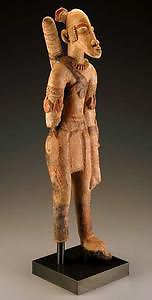3.7: Empire of Mali
- Page ID
- 154813
\( \newcommand{\vecs}[1]{\overset { \scriptstyle \rightharpoonup} {\mathbf{#1}} } \)
\( \newcommand{\vecd}[1]{\overset{-\!-\!\rightharpoonup}{\vphantom{a}\smash {#1}}} \)
\( \newcommand{\id}{\mathrm{id}}\) \( \newcommand{\Span}{\mathrm{span}}\)
( \newcommand{\kernel}{\mathrm{null}\,}\) \( \newcommand{\range}{\mathrm{range}\,}\)
\( \newcommand{\RealPart}{\mathrm{Re}}\) \( \newcommand{\ImaginaryPart}{\mathrm{Im}}\)
\( \newcommand{\Argument}{\mathrm{Arg}}\) \( \newcommand{\norm}[1]{\| #1 \|}\)
\( \newcommand{\inner}[2]{\langle #1, #2 \rangle}\)
\( \newcommand{\Span}{\mathrm{span}}\)
\( \newcommand{\id}{\mathrm{id}}\)
\( \newcommand{\Span}{\mathrm{span}}\)
\( \newcommand{\kernel}{\mathrm{null}\,}\)
\( \newcommand{\range}{\mathrm{range}\,}\)
\( \newcommand{\RealPart}{\mathrm{Re}}\)
\( \newcommand{\ImaginaryPart}{\mathrm{Im}}\)
\( \newcommand{\Argument}{\mathrm{Arg}}\)
\( \newcommand{\norm}[1]{\| #1 \|}\)
\( \newcommand{\inner}[2]{\langle #1, #2 \rangle}\)
\( \newcommand{\Span}{\mathrm{span}}\) \( \newcommand{\AA}{\unicode[.8,0]{x212B}}\)
\( \newcommand{\vectorA}[1]{\vec{#1}} % arrow\)
\( \newcommand{\vectorAt}[1]{\vec{\text{#1}}} % arrow\)
\( \newcommand{\vectorB}[1]{\overset { \scriptstyle \rightharpoonup} {\mathbf{#1}} } \)
\( \newcommand{\vectorC}[1]{\textbf{#1}} \)
\( \newcommand{\vectorD}[1]{\overrightarrow{#1}} \)
\( \newcommand{\vectorDt}[1]{\overrightarrow{\text{#1}}} \)
\( \newcommand{\vectE}[1]{\overset{-\!-\!\rightharpoonup}{\vphantom{a}\smash{\mathbf {#1}}}} \)
\( \newcommand{\vecs}[1]{\overset { \scriptstyle \rightharpoonup} {\mathbf{#1}} } \)
\( \newcommand{\vecd}[1]{\overset{-\!-\!\rightharpoonup}{\vphantom{a}\smash {#1}}} \)
Contributions of the Empire of Mali
To European eyes, particularly those who had settled in the port areas and engaged in the slave trade, Africa embodied the same “primitiveness” that the American indigenous populations did; this is part of what allowed race-based slavery to thrive, throwing off the balance of genders and causing many civil conflicts. However, one area of Africa, a region in the northwestern section of the continent, was not nearly as affected by this issue. Located in the larger northwestern region of the African continent, the Empire of Mali established itself in the twelfth century, reaching its peak in the fourteenth century, and finally declining by dividing into separate states in the early seventeenth century.

Imperial Growth and Decline
The leaders of the Mali empire assumed the name mansa, which translates loosely to leader in the language used during the height of the Mali empire, Mandinka. As it expanded, the leadership wasn’t necessarily handed down from father to son, even though it was a patriarchy. Instead, many times there was an adopted son or brother within the family who, through military prowess, could usurp the throne and show himself as an effective ruler. This led to a number of civil wars and rebellions during the thirteenth century, ultimately helping to expand the empire under each successive ruler and reaching its pinnacle as an empire during the early and mid fourteenth century.
By the fifteenth century, however, they were facing threats not only from within Africa but also from outside. Portugal started to encroach on their western territory as they moved down the African coast in the fifteenth century while establishing outposts in the areas they conquered. However, warriors from Mali were able to suppress the onslaught through a combination of lighter watercraft to outmaneuver the Portuguese caravels and poison-tipped arrows of skilled archers (see Figure 3.7.1) who made up the Mandekalu, the ruler’s official guard. This repelling of Portugal forced the Portuguese king to seek peace between them and Mali in 1465, with a trade agreement between the two territories by 1462. After that, few European traders outside of the Portuguese interacted directly with the Mali empire before its collapse in the seventeenth century.
The domestic problems faced by the various mansa who oversaw the administration of the empire included threats from opposing tribes and growing territories, such as the Songhay, a Muslim-based civilization, who frequently performed raids into the imperial lands on the outskirts of Mali. During the fifteenth century, there was a brief respite from these various smaller incursions, but they would continue to contribute to unrest and shaky government within Mali, as well as to their eventual collapse, which culminated in the Battle of Jenne between the Mali and Arma, a smaller tribal territory who took over regions once belonging to the Songhay. Although they were somewhat cowed by the size of the mansa’s army, they ended up with the victory, and the empire split into five different kingdoms by the beginning of the 1600s.
- In what ways were the civilizations and empires of Eastern Asia and Western Africa similar? How did interaction – or lack thereof – with other outside cultures affect the development of these civilizations?
- What enabled the growth of the Mali empire? how did they avoid the issues that plagued other Western African countries and territories during the same time?

